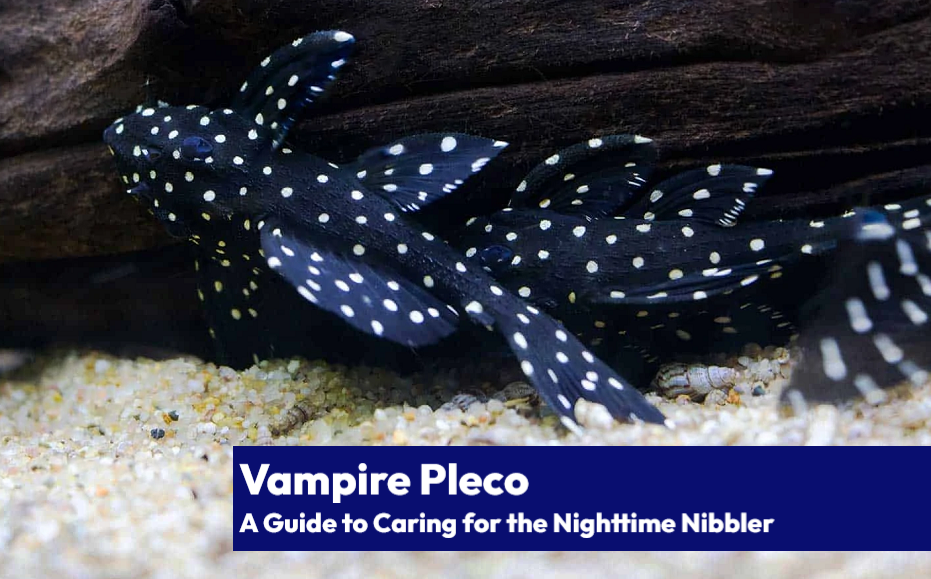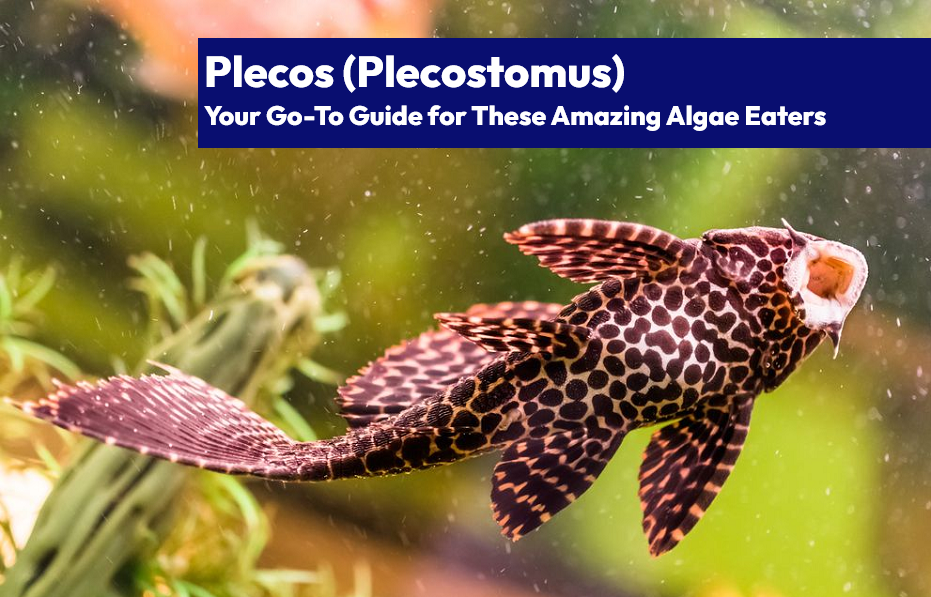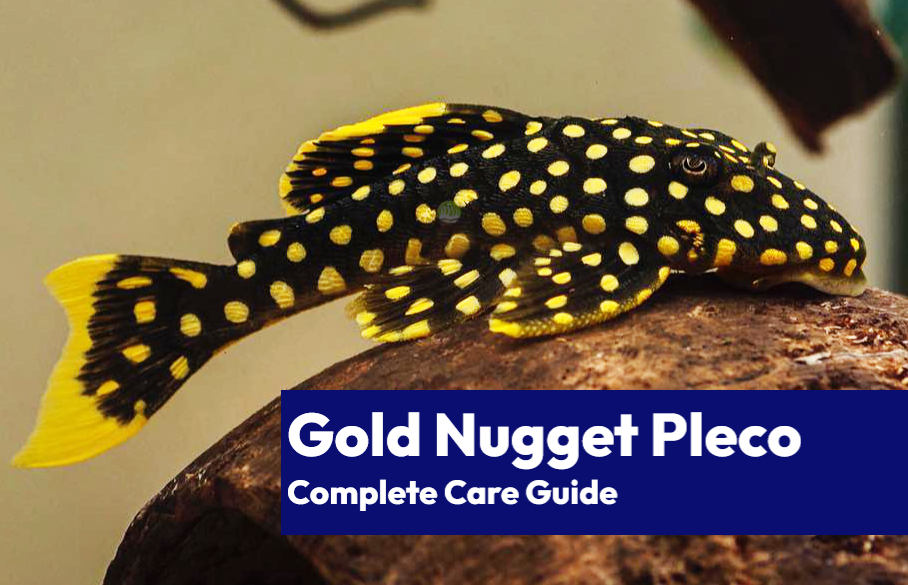Ever wanted a vacuum cleaner for your aquarium? Let me introduce you to the Common Pleco (Hypostomus plecostomus) – a fish that not only does a great job of keeping your tank clean but also looks cool while doing it. So, strap in and let’s explore the exciting world of plecos!
The Common Pleco Lowdown
This armored catfish with sucker mouth is a favorite among hobbyists for their ability to control algae in the tank. But there’s more to these gentle giants than just being your tank’s clean-up crew. Here’s a quick rundown of their essential care data:
| Care Data | Common Pleco |
|---|---|
| Scientific Name | Hypostomus plecostomus |
| Type | Armored Catfish |
| Adult Size | 12-24 inches (30-60 cm) |
| Tank Size | 125 gallons (473 L) |
| Optimal Temperature | 73-82°F (23-28°C) |
| General Hardness dGH | 4-18 dGH |
| Carbonate Hardness dKH | 3-10 dKH |
| Optimal pH range | 6.0-7.5 |
| Diet Type | Omnivore |
| Feeding Frequency | Daily |
| Water Change Frequency | 30% Weekly |
| Can Breed In Captivity | Yes |
| Number of Fry | 300-500 |
| Spawning Type | Cavity spawner |
| Native Range | South America |
| Temperament | Peaceful |
| Schooling/Shoaling Fish | No |
| Known to Jump Out of Tank | Rare |
| Average Cost (USD) | $10-25 |
The Pleco Dress Code

When it comes to looks, the Common Pleco has a unique charm. Sporting a mottled brown and olive-green coloration, they blend seamlessly with their surroundings. Their elongated body is covered in bony plates, giving them a prehistoric appearance.
Common Plecos exhibit sexual dimorphism, which means there are some differences between males and females. Males have a more elongated body and a broader head, while females are generally plumper with a smaller head. Additionally, males develop more pronounced “odontodes” (bristle-like projections) around their mouth, which are used for fighting and breeding.
💡 Fun Fact: These fish have the ability to change their colors slightly based on their environment!
Let’s Talk Pleco Anatomy
These fish are specially designed for their bottom-dwelling lifestyle. Their pectoral fins and abdominal area are modified to form a sucker-like mouth that allows them to latch onto surfaces and feed. Equipped with strong jaw muscles, their mouth is filled with rows of comb-like teeth, perfect for scraping algae off surfaces.

Their pectoral and dorsal fins are tipped with sharp spines, which they use as a defense mechanism against predators. These spines can lock into place, making it difficult for predators to swallow them. An interesting feature of the pleco is their ability to breathe through their intestines, allowing them to survive in low oxygen environments.
Size Matters: Pleco Edition
The average size of a Common Pleco in captivity is around 12-24 inches (30-60 cm) in length. They can grow quite rapidly when given the right care, reaching around 6 inches (15 cm) within their first year. Growth rates vary depending on factors such as diet and water quality, you’ll want to provide optimal conditions to ensure a healthy growth rate.
Life Expectancy of the Common Pleco
The average lifespan of a Common Pleco is between 10-15 years, although they can live up to 20 years or more in the right environment. Proper care, diet, and regular water changes are crucial factors in ensuring a long and healthy life for these fascinating fish.
Tank Size: Bigger is Better
A minimum tank size of 125 gallons (473 L) is recommended for a single Common Pleco. This allows them enough space to move around and grow comfortably. If you plan on adding more fish or a school of smaller tankmates, consider opting for a larger tank.
The Perils of Unprepared Pleco Purchases: Size Matters! 😲
It’s not uncommon for new aquarists to fall in love with the cute, small Common Pleco juveniles sold in pet stores, unaware of their potential to grow into large, hulking creatures. Many hobbyists don’t realize that these little fish can grow to over 24 inches (60 cm) in length, often resulting in shock and dismay when their once-small Pleco starts to outgrow its tank.

Before purchasing a Common Pleco, always ensure you have the space and resources to accommodate their adult size. Remember, a 125-gallon tank is the minimum recommended size for these gentle giants.
💡 Pro Tip: When selecting a Pleco for your aquarium, consider one of the smaller species if you don’t have the space for a full-sized Common Pleco. Many smaller Pleco species are just as fascinating but won’t require such a large tank such as the Bristlenose Pleco or Rubber Lip Pleco.
Keep it Wild: Don’t Release Your Pleco 🚫
If you find yourself unable to care for your Common Pleco due to its size or other factors, it’s crucial to remember that releasing it into the wild is never an option. Non-native species, like the Common Pleco, can cause severe damage to local ecosystems by competing with native species for food and habitat or introducing diseases. Invasive populations of Common Plecos have already caused problems in various regions, including Florida and Texas, where they disrupt native fish populations and damage aquatic plant life.

Instead, try to find a suitable new home for your Pleco by contacting local fish stores, aquarium clubs, or fellow hobbyists who have the necessary space and resources to care for these beautiful fish. Your local fish community will likely be more than happy to help you find a loving home for your finned friend.
Water Parameters for Common Plecos
The ideal water temperature for Common Plecos is 73-82°F (23-28°C), with a pH range of 6.0-7.5. General hardness should be between 4-18 dGH, and carbonate hardness between 3-10 dKH.
Create the Perfect Pleco Paradise
To make your Common Pleco feel right at home, you’ll need to provide the appropriate equipment. Start with a high-quality canister filter to maintain water quality, such as the Fluval FX6. A heater rated for your tank size is essential – for a 125-gallon tank, a 300-watt heater like the Eheim Jager is a great choice.
For lighting, an LED light with a built-in timer (such as the Fluval Plant 3.0 LED) will help simulate a day/night cycle and encourage plant growth. Don’t forget to include a powerhead for water flow, like the Hydor Koralia Nano, to keep your pleco happy.

Habitat Sweet Habitat
The Common Pleco prefers a soft, sandy substrate and plenty of hiding spots. Driftwood and rocks can be used to create caves and crevices for your pleco to hide and explore. Live plants are a great addition, but be cautious as plecos may occasionally nibble on them. Ideal plant choices include Anubias, Java Fern, Vallisneria, Cryptocoryne, and Amazon Sword.
Diet: A Pleco’s Gourmet Menu
Common Plecos are omnivores, which means they enjoy a mix of plant and animal-based foods. A varied diet ensures they receive all the nutrients they need. Some great food options include:
- Algae wafers
- Spirulina flakes
- Blanched vegetables (such as zucchini, cucumber, and spinach)
- Sinking pellets
- Bloodworms
- Brine shrimp
- Mysis shrimp
- Repashy gel food
- Fruit (such as apple, banana, and melon)
Feeding should be done daily, with enough food to be consumed within a few minutes.
Social Butterflies or Loner Plecos?
Common Plecos are generally peaceful and can coexist with a variety of tankmates. Ideal companions include:
However, avoid housing plecos with aggressive or territorial fish like Cichlids and Oscars, as they can cause stress and harm to your pleco.
Breeding: A Common Pleco Love Story
Breeding Common Plecos can be challenging, but not impossible. They are cavity spawners, which means they lay their eggs in a cave or crevice. Providing ample hiding spots and stable water conditions can encourage breeding behavior. Males will guard the eggs until they hatch, usually within 5-10 days. The fry can be fed a diet of crushed flakes, baby brine shrimp, and micro-worms as they grow.
Diseases and Illnesses: Prevention is Key
Common Plecos can be susceptible to various diseases and illnesses, including:
- Ich
- Fungal infections
- Bacterial infections
- Swim bladder issues
- Parasites
To prevent these ailments, maintain optimal water quality, provide a balanced diet, and quarantine new fish before adding them to your main tank.
From the Amazon to Your Aquarium
Common Plecos are native to the Amazon River Basin in South America. They can be found in a range of habitats, from fast-flowing rivers to slow-moving streams and flooded forests.
💡 Fun Fact: Common Plecos are also known as “suckermouth catfish” due to their specially adapted mouths that allow them to attach to surfaces and graze on algae.
Taxonomy and Close Relatives
The Common Pleco’s closest relatives in the aquarium hobby are the many other species within the Hypostomus genus. These fish are all part of the larger Loricariidae family, which includes over 900 species of armored catfish.
| Kingdom | Phylum | Class | Order | Family | Genus | Species |
|---|---|---|---|---|---|---|
| Animalia | Chordata | Actinopterygii | Siluriformes | Loricariidae | Hypostomus | Hypostomus plecostomus |
Wrapping Up: Your Guide to Common Pleco Care
So there you have it, folks! Everything you need to know about keeping the Common Pleco in your home aquarium. Just remember, these fish can grow quite large, so it’s essential to provide them with ample space, a well-rounded diet, and the appropriate tankmates to ensure they thrive.
TL;DR:
- Common Pleco: Hypostomus plecostomus
- Omnivorous diet
- Minimum 125-gallon tank size
- Lifespan: 10-15+ years
- Peaceful temperament
- Can be challenging to breed
- Native to the Amazon River Basin

Tim Priest, a renowned aquarium expert with over 15 years of experience in aquatic gardening and fish education, is dedicated to helping enthusiasts create stunning and thriving aquatic environments. As the founder of LearnTheAquarium.com, Tim shares his wealth of knowledge, passion, and expertise through engaging articles, educational resources, and personalized advice.
Discover the secrets to creating captivating underwater landscapes and maintaining healthy aquatic ecosystems. Join Tim on an exciting journey and let your aquarium adventure begin!






